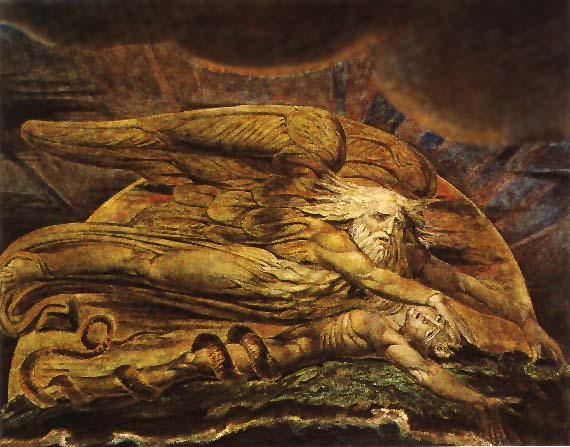
Blake's Elohim Creating Adam
Russell’s latest post on Alter and Frye has got me thinking about my longstanding assumptions about Frye, particularly with regard to the Bible and literature. The Bible and literature occupy the centre of Frye’s critical universe, and understanding what he says about both is to appreciate the full potential of his critical vision.
The Judeo-Christian Bible as the supreme artifact of Christian culture down to about the 18th century is of course easy enough to assume. As Frye points out, the Bible is a primary source of imagery and stories well into the 20th century — and, in these apparently apocalyptically-minded times, into the 21st century as well.
But the Bible is not just a source of mythos and dianoia, to use the Aristotelian terms Frye adapts in Anatomy. It is the source also of a “unique” arrangement of myth and metaphor represented by typology, the progressive succession of type-antitype-type (e.g. Creation-Incarnation-Revelation). Although Frye rather conspicuously only says it once, he nevertheless observes on page 80 of The Great Code:
The typological organization of the Bible does present the difficulty, to a secular literary critic, of being unique: no other book in the world, to my knowledge, has a structure even remotely like that of the Christian Bible.
That structure is the “double mirror” of the Old Testament and the New Testament — the latter concealed in the former and the former revealed by the latter — which provides the Christian Bible’s kerygmatic vision of the human condition that Blake characterizes as the revelation of the “human form divine.” The typological structure of the Christian Bible that furnishes its distinctive double mirror character, however, does not originate with Christianity: the Hebrew Bible is the source of these typological principles, and the first “Christians” were themselves Jews who compiled what would become their “new” testament using the same typological structure of their traditional holy scriptures. As Frye observes:
Typology in the Bible is by no means confined to the Christian version of the Bible: from the point of view of Judaism at least, the Old Testament is much more genuinely typological without the New Testament than with it. There are, in the first place, events in the Old Testament that are types of later events recorded also within the Old Testament. (GC, 83)
When Frye suggests, therefore, as he does in The Great Code (and there alone, it might be pointed out) that the culturally ascendant phases of language we have observed so far — the hieroglyphic, the hieratic, and the demotic — may be, for the first time in human history, about to be succeeded by a kerygmatic phase, he is making about as revolutionary a statement as he ever made. I’m not sure it is possible to approach his work as a whole without thinking about its implications.